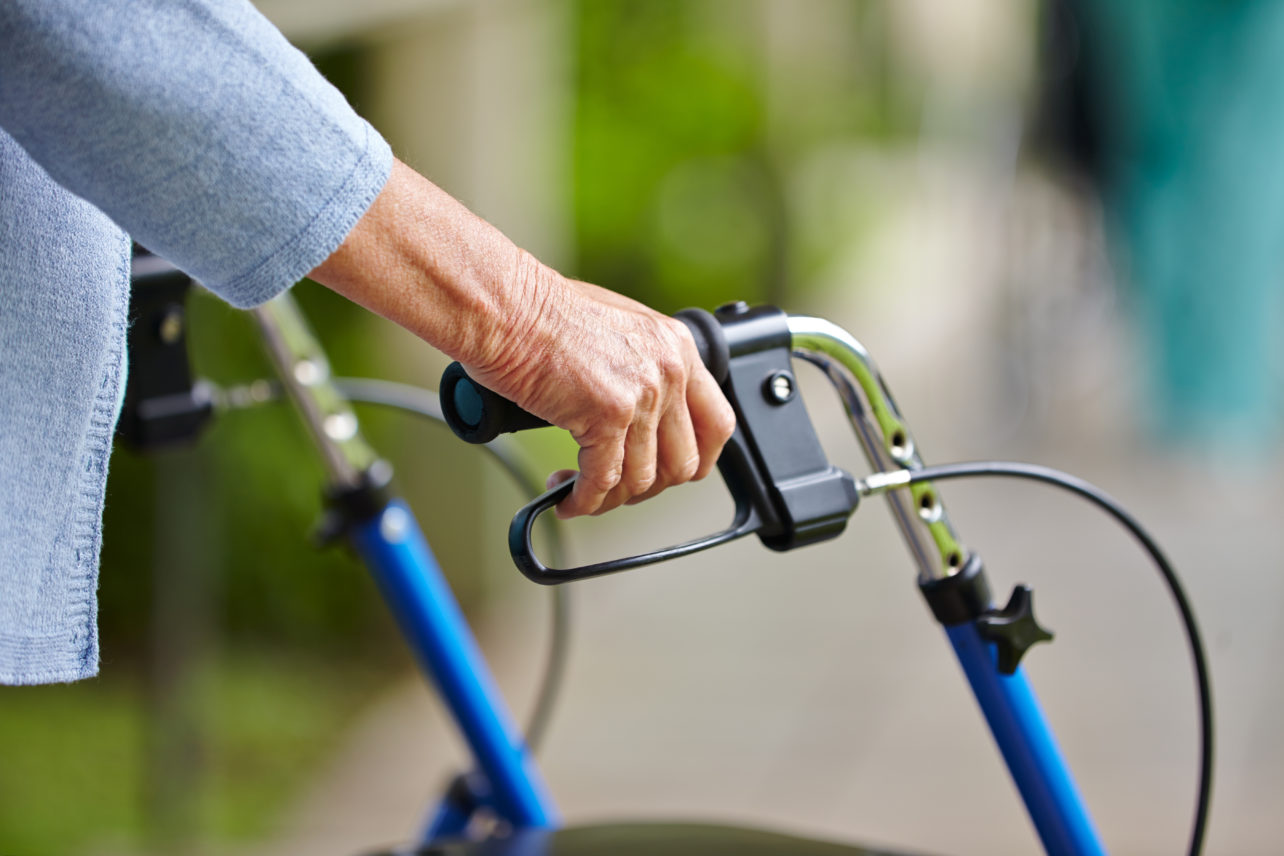As you age, you could find that you need some assistance when moving around. In some cases, you might only need a cane or walking stick to lean on. You could also need more support like that provided by a walker. For someone who needs more support than a cane but who does not need the full support that a standard walker provides, a rollator may be the best option.
What is a rollator?
A rollator is a mobility device that can be used by persons who are still able to stand and move around but need a little extra support. They allow you to enjoy an active lifestyle while aging in place and give you the freedom to enjoy social gatherings, run errands, or simply move around in your home.
When you use a rollator, you will be able to walk at your normal pace and gait. The braking system gives you control over your rollator. This is especially important if you’ll be using it on smooth surfaces or areas that are inclined.
Rollators are also sometimes called rolling walkers, medical rolling walkers, or wheeled walkers.
The differences between a rollator and a traditional walker.
Sometimes rollators and walkers are used interchangeably, but they are not the same thing. A traditional walker is a frame that is placed in front of you to provide support and stability while you move around. The frame has four legs and needs to be picked up, moved forward (or to the side), and placed back down before you can take a few steps in the direction that you want to move. While a traditional walker provides support, it requires some upper body strength to move the device and could make you tired quicker. Traditional walkers are best suited for individuals who require more support or need to be able to place most of their weight on their mobility device while they move about.
Rollators are similar to traditional walkers, but they have two, three, or four wheels. Sometimes two wheel rollators are also called walkers. The wheels make it easier to move the rollator around, conserving your energy. A rollator resembles a pushcart. The handlebars have a braking system that helps to prevent falls that could occur from a rollator sliding away from you. The braking system usually involves handbrakes and a brake cable that is connected to the wheels. Some rollators have seats and baskets or pouches where you can stow your personal items.
Traditional walkers could provide more support for persons who need added stability or need a device that can take all their body weight. On the other hand, a person who needs a rollator usually only requires some assistance when standing or walking around.
How to choose a walking aid.
The primary purpose of a walking aid is to provide balance, support, and stability as you move around. Different types of walking aids are designed to meet these needs in slightly different ways. When choosing a walking aid, you need to consider which one will support you best.
Walking canes provide nominal support and may be all you require when walking short distances or moving around in crowded or tight spaces. A rollator is best for people who do not have problems with balance but need some added assistance when walking longer distances. Walkers provide more support than rollators, as you can place all, if not most, of your weight on the walking aid if you need to.
Persons who require more assistance could benefit from a mobility scooter, knee walker, transport chair, or wheelchair.
Things to consider when looking for a rollator.
Rollators come with many different features. These features relate to where you will be using your rollator, how you will be using it, and any additional elements that may suit your unique needs.
Where you will be using your rollator.
It is relatively easy to move from one type of surface to another with a rollator. In most cases, the wheels can effortlessly accommodate the transition. On the other hand, the wheels could make it more challenging to walk on slanted surfaces. The brakes provide some stability, but two wheel rollators or traditional walkers may be a better option if you use the device in areas where you regularly need to walk up or downhill.
Rollators have different kinds of wheels and different wheel sizes. These wheels swivel to make it easy to maneuver the rollator. Some rollators have larger wheels (between eight and ten inches in diameter) made of a softer rubber, while others have smaller wheels (about six inches in diameter) made of harder rubber. The larger wheels are made of soft rubber and better on rough terrain and uneven surfaces like gravel and grass. These are often found on heavy duty rollators designed for outdoor use. Smaller and harder wheels work best on smooth surfaces like paving, carpeting, hardwood, or tile flooring. These types of wheels are usually found on indoor rollators.
Suppose you will be using your rollator walker inside. In that case, you need to consider the width of your doorways and hallways when choosing the right rollator for you. The rollator should be wide enough to give you adequate support, but it should also easily fit through the narrower spaces in your home. Slightly smaller rollators may be more suitable for smaller spaces like kitchens and bathrooms.
Three wheel rollators are often easier to maneuver. They can make sharp turns and fit into smaller spaces than 4 wheel walkers. These rollators are also lighter, mainly because they don’t have a built-in seat.
Your upper body strength.
While standard rollators are designed to make moving around more manageable, you will still need to push it around as you go. That means you will need to use some upper body strength. Most rollators weigh between seven and twelve pounds. Outdoor rollators could weigh between fifteen and twenty-five pounds. This may sound heavy, but the wheels make it easy to move the rollator around.
You will also need enough strength in your hands to use the hand brakes. This is vital since your rollator may get away from you if you cannot fully engage the brakes.
How stable you are on your feet.
If you aren’t very stable on your feet, you may find it difficult to control a 4 wheel rollator. While these devices can help you get around, they may also promote falling. This could occur if you struggle to engage the brake while you are adjusting the wheels or walking along an incline. You may want to consider a rollator with two wheels instead of four. That way, at least two of the device’s legs can be firmly placed on the ground while you are walking, without the need of engaging a handbrake.
Height and weight capacity.
Most rollators have various adjustment options (like different seat and handle heights) to accommodate different people. It should be easy for you to make any necessary adjustments to your rollator. Even then, each rollator usually has a height and weight range that it is best suited for. If your rollator is too short, you will have to bend down to reach the handlebars. This could cause backaches and strained muscles. On the other hand, if the handlebars of your rollator are too high, it might not provide you the stability and support that you require, and you may struggle to control it.
Similarly, the seat height should be adjustable to fit your needs. A seat that is too low could be uncomfortable for a tall person. On the other hand, a seat that is too high could be hazardous for shorter individuals.
Generally, rollators can support persons weighing up to 250 pounds. However, some rollators, called bariatric rollators, can accommodate persons weighing up to 500 pounds.
Would you be able to use it by yourself?
Many people who use mobility devices like rollators do so because they enjoy the independence that these devices bring them. Therefore, it is essential that you should be able to use your rollator without assistance unless you have someone who provides in home care. Your rollator should give you the stability and support you need while still being compact and lightweight enough that you can move it around or load it into or out of your car.
Additional features.
The essential parts of all rollators are a frame and wheels. Some rollators have additional features that could make them an even better choice for you. For example, some rollators have a padded seat that you can use when resting. If you’re planning on purchasing a rollator with a seat, make sure that the seat is comfortable, especially if you will be using your rollator in areas or situations where you may need to use the seat for long periods of time. You may even want to consider looking for a rollator that has a padded backrest incorporated into the seat.
The handlebars should be comfortable to hold on to without placing strain on your arms or hands. You also need to be able to engage the brakes quickly and easily. If you will be using your rollator for more extended periods, uncomfortable hand grips and brakes might make your hands tired. This could potentially make for unsafe situations if you are unable to brake when you need to. Ergonomic handles are specifically designed to avoid hand fatigue and make using your rollator more comfortable.
Your rollator could have a basket or bag where you can place your shopping or personal items. These can also come in handy to carry tools and supplies while you are gardening. The basket or storage space should be large enough to hold your personal items or shopping without making your rollator unnecessarily bulky.
Many rollators can be collapsed or folded up for easy storage. These are ideal if you have limited storage space or need to transport your rollator in your car. On the other hand, collapsible rollators may be slightly less sturdy and durable as they have more moving parts.
How to pay for a rollator.
Low-end rollators can start from just over a hundred dollars. Higher-end models could cost a few hundred dollars. In most cases, Medicare insurance would cover the cost of your rollator as these mobility aids are included in Medicare’s list of covered durable medical equipment. In these cases, your Medicare-approved physician will need to order your mobility aid and confirm that it is medically necessary.
You will likely need to purchase or lease your rollator through a Medicare-approved supplier if you go this route. There is a chance that you may be responsible for paying twenty percent of the Medicare-approved amount. If this is the case, you may need to make payments in addition to your premium payments until you’ve met your annual deductible.
Rollators provide support to persons who are still able to move freely. They help you maintain your independence while moving around in your home, attending social events, or running errands. Rollators are easy to maneuver, and many have built-in seats and baskets to make your outings even more enjoyable. When looking at the best rollators, keep in mind that the best rollator is the one that suits your needs the most.




